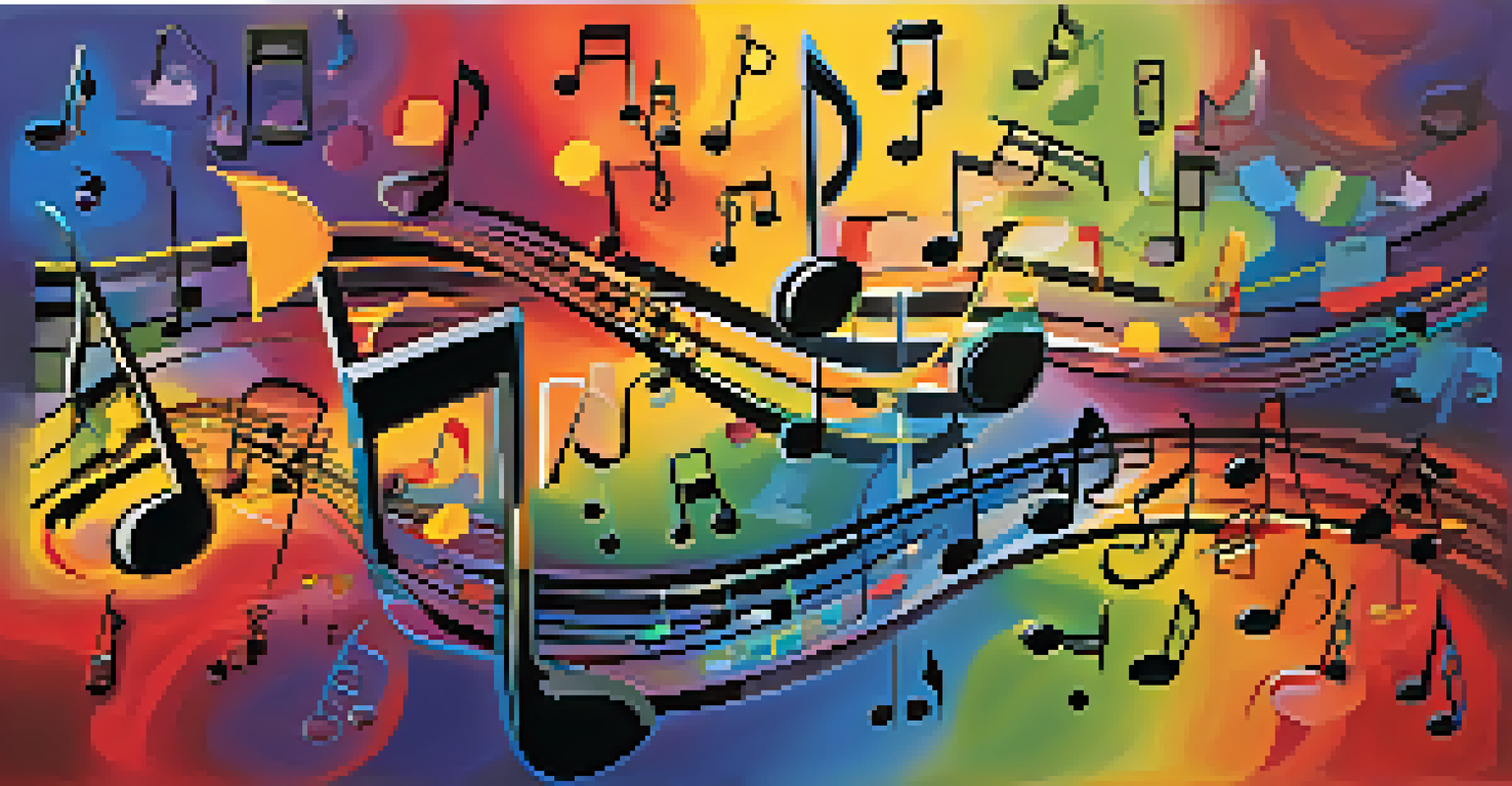Common Symbols in Guitar Music Notation: A Quick Reference

Understanding the Staff and Clefs Used in Guitar Music
At the heart of guitar music notation is the staff, which comprises five lines and four spaces. For guitarists, the treble clef is predominantly used, as it effectively represents the notes played on the guitar. Each line and space corresponds to specific notes, making it essential for players to familiarize themselves with this layout.
Music can change the world because it can change people.
The treble clef, often resembling a fancy cursive 'G', indicates where the note G is located on the staff. This is crucial since it sets the foundation for all other notes, allowing guitarists to read and play music accurately. Notably, guitarists typically read music in the treble clef even when playing bass lines.
Understanding the staff and clefs is the first step toward deciphering guitar music. Once you grasp how notes are organized within the staff, you'll find it easier to read melodies and chords, empowering you to play your favorite songs with confidence.
Notes and Their Placement on the Staff
Notes are the building blocks of music, and their placement on the staff indicates their pitch. In the treble clef, the notes on the lines from bottom to top are E, G, B, D, and F, while the notes in the spaces spell out 'FACE.' Knowing these placements is vital for any guitarist aiming to read music effectively.

For example, if you see a note on the second line of the staff, you should recognize it as G. This simple system allows you to translate visual symbols into sound, bridging the gap between reading and playing. The more you practice, the quicker you'll identify notes and improve your overall musicality.
Understanding Guitar Notation Basics
Familiarity with the staff and treble clef is essential for guitarists to accurately read and play music.
As you become familiar with note placements, try using flashcards or apps that quiz you on note identification. This can significantly enhance your ability to read music, making it easier to tackle more complex pieces in the future.
Common Rhythmic Notation: Understanding Note Values
In addition to pitch, music notation conveys rhythm through various note values. Whole notes, half notes, quarter notes, and eighth notes each represent different durations – from the lengthy whole note to the quicker eighth note. Understanding these values is crucial for timing while playing.
The beautiful thing about learning is that no one can take it away from you.
For instance, a quarter note lasts for one beat, while a half note lasts for two beats. This means that if you're playing a piece that includes both, you'll need to adjust your strumming or picking accordingly. Mastering the relationship between note values and beats is essential for playing in time with other musicians.
As you practice, try clapping or tapping out the rhythms of different note values before playing them on your guitar. This simple exercise can significantly improve your timing and help you internalize rhythmic patterns.
The Importance of Rest Notation in Music
Just as notes indicate sound, rests signify pauses in music. Each rest has a corresponding duration, much like notes – a whole rest, half rest, quarter rest, and eighth rest. Rests are essential for creating dynamics and phrasing in your playing.
For instance, a quarter rest indicates a one-beat pause, allowing for a natural break in the music. Understanding where to insert these rests can enhance your performance, adding expressiveness and allowing melodies to breathe. It's not just about playing the notes; it's about knowing when to let silence speak.
Importance of Rhythm and Dynamics
Mastering note values and dynamics enhances timing and emotional expression in guitar music.
Incorporating rests into your practice routine will help you balance sound and silence effectively. Try playing a simple melody while consciously adding in the rests to notice how it affects the overall feel of the piece.
Key Signatures: The Foundation of Musical Tonality
Key signatures indicate the tonal center of a piece of music and determine which notes are sharp or flat. Located at the beginning of a staff, these signatures set the stage for the notes that follow, guiding your fingers to the appropriate frets on the guitar. Understanding key signatures is crucial for playing in tune with other musicians.
For example, a key signature with one sharp indicates that the F note is sharp throughout the piece. Recognizing these patterns will help you anticipate which notes to adjust as you play, ensuring that your performance aligns with the intended tonality.
As you delve into different key signatures, consider playing scales associated with each. This practice will not only reinforce your understanding but also improve your finger positioning and familiarity with the guitar's fretboard.
Chords and Their Notation in Guitar Music
Chords are the harmonic backbone of many guitar pieces, and their notation can vary from standard notation to tablature. In standard notation, chords are often represented by vertical lines or symbols above the staff, indicating which notes to play simultaneously. Understanding chord notation is vital for any guitarist looking to strum along with songs.
For instance, a 'C' chord in standard notation will typically appear as a symbol on the staff, while its tablature will show you the specific frets and strings to play. This dual notation system allows you to choose the method that works best for you, whether you're reading sheet music or using tabs.
Chords and Key Signatures Matter
Grasping chord notation and key signatures is crucial for playing harmoniously with other musicians.
To master chord progressions, practice switching between common chords while keeping an eye on the notation. This will help you build your muscle memory and enhance your ability to flow smoothly from one chord to the next.
Dynamics and Articulation: Expressing Emotion in Music
Dynamics and articulation symbols guide how loudly or softly to play, as well as how to express various musical phrases. Terms like 'piano' (soft) and 'forte' (loud) indicate volume levels, while symbols such as staccato (short and detached) or legato (smooth and connected) suggest how to articulate notes.
For example, if a section of music calls for 'piano,' you'll want to play gently, allowing the nuances to shine through. Conversely, a 'forte' marking invites a more powerful performance, giving you the freedom to express emotion and intensity.

Incorporating dynamics and articulation into your playing can elevate your interpretations of songs. Experiment with different levels of volume and note articulation to discover how they affect the overall feel of the music.
Conclusion: Putting It All Together in Your Guitar Playing
By understanding these common symbols in guitar music notation, you'll unlock the ability to read and interpret music with greater ease. Whether you're a beginner or a seasoned player, having a solid grasp of these elements will enhance your musicality and overall enjoyment of playing. Remember, practice makes perfect.
Start by applying your knowledge to simple pieces, gradually working your way up to more complex compositions. As you become more comfortable with reading notation, you'll find that it enriches your playing experience and opens up new avenues for creativity.
Ultimately, the goal is to enjoy your time with the guitar while continuously learning. With each song you tackle, you'll not only improve your skills but also deepen your appreciation for the art of music.